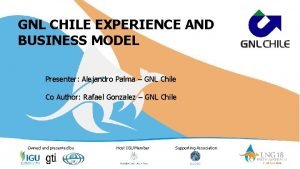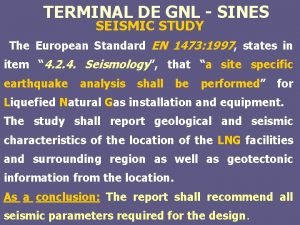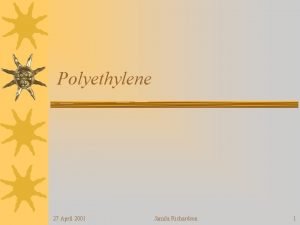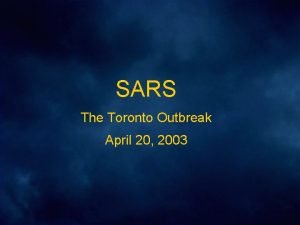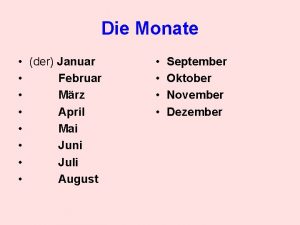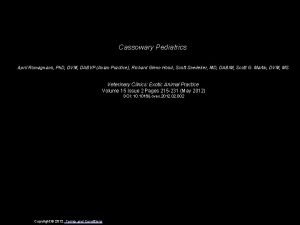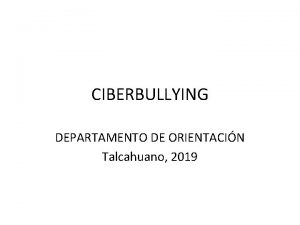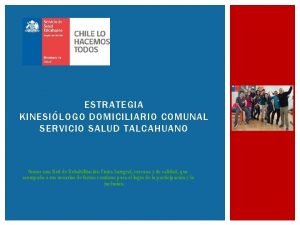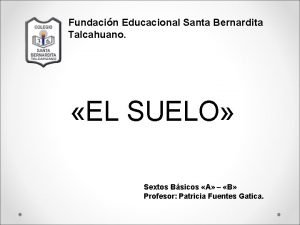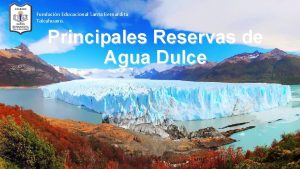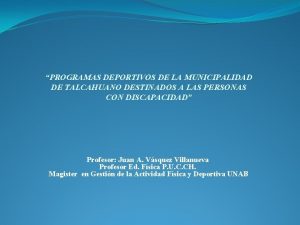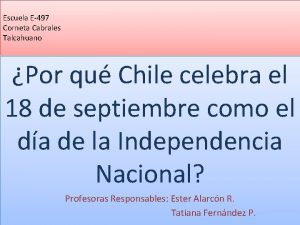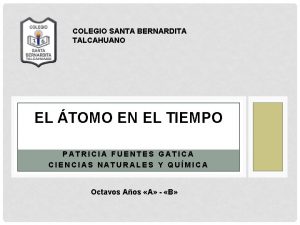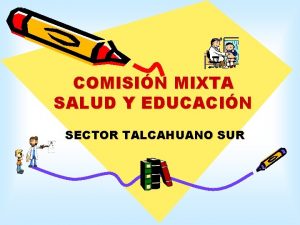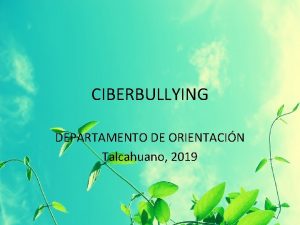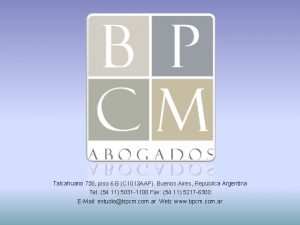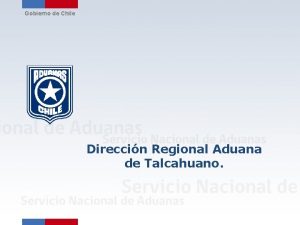GNL Talcahuano April 2020 OVERVIEW GNL Talcahuano is













- Slides: 13

GNL Talcahuano April 2020

OVERVIEW • GNL Talcahuano is a Chile-based Liquefied Natural Gas (LNG) Import project, widely regarded as the preeminent investment jurisdiction in Latin America with US FTA status, low political and currency risk and a well-regarded rule of law. • The South Central Chilean energy market has 0. 2 MTPA of non-seasonal firm supply annually, yet demand in excess of 1. 5 MTPA coming from power, industrial, residential and export consumers in the VII - X Regions. • The project will be a marine-based FSRU and the site is uniquely positioned given 1) a natural island breakwater 2) a fully built out international pipeline network and 3) 95 -98% utilization given benign metocean conditions. • GNL Talcahuano is a net beneficiary of both LNG oversupply and economic uncertainty in Argentina. The Vaca Muerta shale project is in jeopardy due to low oil prices and unstable government policies. This development will again turn Argentina to a net importer of a minimum 1 MTPA of LNG. Chile presents a safe and secure source of LNG for Buenos Aires’ 30 mm residents. • The project is “shovel ready” from a permitting perspective with anticipated FID (Final Investment Decision) in 1 Q 2021 and Commercial Operations in 1 Q 2023. • At LNG volumes of 1. 5 MTPA GNLT will generate normalized EBITDA of $140 mm USD. This is a conservative estimate since the project’s total volume could easily reach or exceed 3 MTPA. 2

Humanitarian & Environmental Basis: Chile Our project’s mission is to clean up the world’s worst air pollution • South Central Chile suffers from the world’s worst air pollution, exceeding even that of New Delhi or Beijing. This region, highly industrialized and with heavy activity by forestry and fish farming companies, is subjected to the use of large volumes of coal, high sulfur diesel, and other dirty fuels, as well as the burning of massive volumes of poisonous wet wood for cooking and heating by the region’s residents. Combined, these fossil fuels lock down the region’s skies under a poisonous smog. • While Chile’s European elite use the country’s anti-pollution laws and billions of dollars of taxpayer’s money to mitigate pollution in the capital region hundreds of miles to the north, the Indigenous people of South Central Chile, the Mapuches tribes and clans, have been left suffering as their air, lands, and waters have been poisoned, their families ravaged by heart and lung diseases, and their children decimated by cancer and neurological disorders, all caused by this air pollution. • Rather than work to reduce South Central Chile’s air pollution, the country’s European elite instead conspired to build a series of massive power plants in the region to provide cheap electricity to the capital area, while the GNL Talcahuano project is based upon cleaning the region’s air, land, and waters, while reducing energy costs for the local Indigenous people and businesses. Our project will decrease energy costs by up to 25%, thereby not forcing Chilean families to make the hard choice between a warm home and being able to by bread and milk for their children. • This People’s Project will bring clean burning natural gas, allowing for a clean energy complex, including wind and solar implementation, as well as clean, green businesses to flourish, and for farmlands, forests, and waterways to be restored as the region’s skies are cleared of poisonous clouds. 3

Humanitarian & Environmental Basis: Argentina • One of the world’s natural treasures, large areas of Argentina’s Patagonia region have been environmentally despoiled and its Indigenous population of the Mapuches nation ravaged with illnesses and genetic diseases caused by the poisonous pollutants resulting from oil and gas fracking, the story of Argentina’s shale fields is a catastrophic disaster. • Over the past 10 years the world’s largest oil companies have savaged the environment and the people of Patagonia through the dumping of millions of gallons of poisonous chemical waste directly into the region’s lands and waters, polluting large tracts of farmlands and grazing pastures, destroying the health and livelihoods of the region’s citizens. • Indigenous Mapuches tribes have been devastated, tens of thousands of acres of their organic fruit orchards destroyed, their herds of goats and cattle decimated, while they and their children suffer from illnesses and genetic deformities caused by fracking driven pollution. • Thankfully, due to Argentina’s withdrawal of subsidies to the world’s richest oil companies and the crash in energy pricing due to Covid, production in the Patagonian shale fields has been reduced to very low levels. This situation is expected to continue for quite some time. • The crash of fossil fuel production in the shale fields of Patagonia presents a unique opportunity to end fracking in the region. The importation of non-fracked natural gas from the GNL Talcahuano import project in Chile would provide Argentinians with cheaper gas than the Patagonian fields, pulling the economics out from under the frackers, thereby keeping these fields shut down. 4

Partnering with the Mapuches for Green Prosperity • GNL Talcahuano, SA is proud and excited to provide the financial and technical support to create a series of sustainable and environmentally friendly projects and companies that will provide a pathway for the regions indigenous tribes to a new circular economy and green prosperity. • The core requirement for each and every project or company developed under the Green Prosperity Pact made between GNL Talcahuano and the Mapuches Nation is that they be True Green, having 100% positive effects upon the environment and people of South Central Chile. • The following is a list of the project companies that are planned under the GNL Talcahuano and Mapuches Nation Green Prosperity Pact: • • • Seaweed drying & packaging: the women of the water clans of the Mapuches harvest seaweed and sell it wet to Asian buyers, realizing only a fraction of its final sale value. A drying, processing, and packaging facility, powered by 100% renewable energy will allow for dry, packaged seaweed to be sold directly to wholesalers, allowing the Mapuches to earn 4 or 5 times the money they are paid for wet seaweed. Sustainable fish farming & aquaponic greenhouses: climate change and overfishing have depleted the region’s natural oceanic fisheries, threatening both the large commercial operators and the small fishing fleets of the Mapuches. It is projected that large and small fishing fleets will be drastically reduced in coming years, a trend already underway. GNL-T will partner with the Mapuches fishing communities to finance and provide the technological basis for a series of aquaponic greenhouses as well as several organically based freshwater fish farms that will be located across the region. Project to restore native plants and trees: massive forestry industries have destroyed thousands of square miles of South Central Chile’s native forests with the introduction of the single specie pine plantations, accurately called the “Green Desert” by the region’s inhabitants. GNL-T and Mapuches clans of the woodlands will partner together to restore thousands of acres to their natural species of plants grasses and trees as well as native animal species over the next 10 years. Many of these restored parcels will be planted with the medicinal plants of the Mapuches peoples, which are being adopted globally as efficient alternative medicines and supplements. A separate business to process, package and market these native medicines will be set up by GNL-T and the Woodland Mapuches tribes. 5

Supreme Court Decision Breaks Big Oil’s Monopoly: Our Project Can Now Bring Low Prices & Clean Air to Chile’s People Elites & Big Oil Allies to Chile’s People: Crippling Prices & World’s Worst Pollution For 5 years, Chile’s elites and their Big Oil allies attempted to block GNL Talcahuano from providing clean, low priced natural gas to the people of South Central Chile through an illegal monopoly that prevented our project’s natural gas from being delivered into the regional and transnational pipeline systems. This was not only a civil violation, but also a criminal felony under Chilean law. Supreme Court to Chile’s People: Economic Relief, Clean Skies, Land & Waters After years of battling the elite’s and Big Oil, GNL Talcahuano won a landmark decision from Chile’s Supreme Court which tore away the illegal monopoly they had used to block our project from delivering natural gas to the people suffering from the world’s worst air pollution. This decision now allows for GNL Talcahuano to begin its mission of cleaning the air, land, and waters for the indigenous Mapuches and all the people of South Central Chile. It also means that families price gouged by Big Oil will no longer have to face the heart-breaking decision of heating their homes or feeding their children. 6

PROJECT ADVANTAGE: OPTIMAL SITE LOCATION & GRID CONNECTION TERMINAL MARÍTIMO GNL TALCAHUANO LOCATION: Concepción Bay TERMINAL MARÍTIMO GNL TALCAHUANO Monopile-Mooring System FSRU Subsea Pipeline Delivery point Existing Pipeline 4 PROTECTED AREA DISTANT FROM HABITED AREAS CONNECTION FEASIBILITY ANNUAL OPERATION The área is naturally sheltered from waves and winds from the north as the Quiriquina Island acts like a natural break water. The operations will take place at more than 4 kilometers away from the inhabited areas, respecting the standards of Sandia Report 2008 -3153 and Sandia Report 2004 -6258, as recommended by the SIGTTO. The Project has a strategic location with a connection to the Gasoducto del Pacífico pipeline, through which it will connect to the whole VIII Region throughout the grids currently operated by the Chilean LDCs INNERGY S. A. , INTERGAS S. A. and GAS SUR S. A. Location that is expected to deliver 95% to 98% uptime. 7

TERMINAL LAYOUT - FSRU JETTY DESIGN Floating Storage Regasification Unit (FSRU) Terminal Production and Storage Capacities FSRU Send out 220 mmscfd FSRU Storage 50, 000 cbm FSU Storage 120, 000 cbm Terminal Capacity 2 MTPA 8

PROJECT TIMELINE AND CRITICAL MILESTONES 9

GNLT(EST) – UNIT ECONOMICS OF LNG TO REGION VIII Market Pricing Metrics LNG Price Assumption 12% Brent Slope =$3. 60/MMbtu DES + $2. 30/MMbtu for Storage + Regasification GP Pipeline Transport 10

COMMERCIAL AND CONTRACTING STRUCTURE 11

GNLT PROJECT ECONOMICS 12

THANK YOU CONTACT Zubin Khambata General Manger z. k@gnl-t. com Colin Williams Executive Director cbw@gnl-t. com 13

